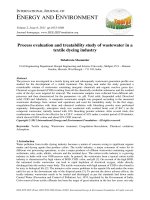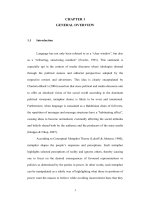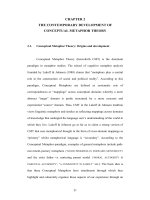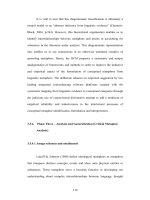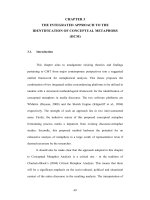Study of antibiotic sensitivity pattern of staphylococcus aureus and comparison of cefoxitin and oxacillin discs for detection of mrsa in a tertiary care hospital
Bạn đang xem bản rút gọn của tài liệu. Xem và tải ngay bản đầy đủ của tài liệu tại đây (206.81 KB, 6 trang )
Int.J.Curr.Microbiol.App.Sci (2017) 6(6): 921-926
International Journal of Current Microbiology and Applied Sciences
ISSN: 2319-7706 Volume 6 Number 6 (2017) pp. 921-926
Journal homepage:
Original Research Article
/>
Study of Antibiotic Sensitivity Pattern of Staphylococcus aureus and
Comparison of Cefoxitin and Oxacillin Discs for Detection of MRSA in a
Tertiary Care Hospital
V. Aruna1, S. Nirmala1* and K.R. Rajendran2
1
Department of Microbiology, Government Mohan Kumaramangalam Medical College,
Salem, Tamil Nadu, India
2
Department of Microbiology, Coimbatore Medical College, Coimbatore, Tamil Nadu, India
*Corresponding author
ABSTRACT
Keywords
MRSA, Cefoxitin,
Oxacillin,
Biochemical.
Article Info
Accepted:
17 May 2017
Available Online:
10 June 2017
Staphylococcus aureus is the commonly encountered pathogen isolated from clinical
specimens. Methicillin resistant Staphylococcus aureus (MRSA) causes variety of human
infections resulting in high rate of mortality and morbidity. The aim of the study was to
screen for MRSA by disc diffusion method using cefoxitin and oxacillin discs and to
determine antimicrobial susceptibility and resistance of Staphylococcus aureus. Two
hundred Staphylococcus aureus were isolated from samples like pus, blood, sputum,
vaginal swab, urine and body fluids received in microbiology department of Coimbatore
medical college hospital. They were confirmed by microscopy, culture and biochemical
reactions. MRSA were detected by disc diffusion test using cefoxitin (30μg) and oxacillin
(1μg) discs. Majority of Staphylococcus aureus were isolated from pus samples (87.5%).
Isolated Staphylococcus aureus strains were highly sensitive to linezolid (100%) and
vancomycin (99%) and 100% resistant to penicillin. Cefoxitin disc detected higher
percentage (26%) of MRSA than oxacillin disc (24%). Detection of MRSA is considered
as very important for treating patients and to prevent its spread.
Introduction
septicemia. Penicillin was the drug of choice
to which Staphylococcus aureus developed
resistance by producing the enzyme beta
lactamase and hence Methicillin was
introduced in 1959. In spite of this, MRSA
appeared and was rapidly spreading in
hospitals in 1961 (Poonam Sood Loomba et
al.,
2010)
Prolonged
hospitalization,
indiscriminate use of antibiotics and in
dwelling medical devices are the cause for the
appearance and spread of MRSA. The
nosocomial multi drug resistant MRSA (HAMRSA) strains have a high effect on patient
Staphylococcus aureus has the ability to
asymptomatically colonize the normal
population either persistently or transiently.
30% of humans are likely to be nasal carriers.
Person to person contact or contact with
fomites plays a role in its transmission. Loss
of normal skin barrier and presence of
predisposing factors such as diabetes and HIV
complicates infection. Staphylococcus aureus
causes human infections such as furuncles,
cellulitis, abscesses,
toxic
Shock
syndrome, Staphylococcal scalded skin
syndrome, endocarditis, pneumonia and
921
Int.J.Curr.Microbiol.App.Sci (2017) 6(6): 921-926
morbidity and mortality. Beta lactam agent’s
binds to PBP in cell wall of Staphylococcus
aureus
resulting
in
disruption
of
peptidoglycan synthesis and bacterial cell
death. The mec A gene coding for PBP2a in
cell wall of MRSA harboured by mobile SCC
mec chromo some is responsible for
methicillin resistance. Detection of MRSA
can be performed by an oxacillin or cefoxitin
disc diffusion test. Cefoxitinisa strong inducer
of mec A gene and thus helps in detection of
MRSA, specific methods for detecting
antibiotic resistance in these pathogens
accurately has become a significant tool in
clinical diagnosis.
tube coagulase test, catalase test and growth
on mannitol salt agar.
The sensitivity to common antibiotics was
done by Kirby Bauer Disc Diffusion method
as recommended by CLSI. Control strains
used were Staphylococcus aureus ATCC 25923 and MRSA–ATCC - 43300.
A swab was submerged in bacterial
suspensionand was inoculated onto, Mueller
Hintonagarplate. The surface of the plate is
swabbed in three directions so that the
reiseven and complete distribution of the
inoculum. Within 15 minutes of inoculation
antibiotic discs were applied usingasterile
forceps. The antimicrobial discsused were
procured from Himedia. The drugs oxacillin
(1µg), cefoxitin (30µg), penicillin (10u),
linezolid (30µg), vancomycin (30µg),
doxycycline (30µg), amoxyclavulanic acid
(30µg,10µg),
cephelexin
(30µg),
cotrimoxazole (25µg), cefotaxime (30µg),
amikacin (30µg), and ciprofloxacin (5µg)
were pressed down to ensure complete
contact with the agar surface and incubated at
37ºC for 24 hrs after which the zone of
inhibition was measured by using zone
measuring scale and interpreted as per the
CLSI standards. In oxacillin disc diffusion
test (Nicole Broekema et al., 2009) zone
diameter of 13mm or more was taken as
sensitive, 11 to 12mm was taken as
intermediate sensitive and 10mm or less is
considered as MRSA. In cefoxitin disc
diffusion test zone diameter of 22mm or more
was taken as sensitive and 21mm or less was
considered as resistant. These resistant
isolates were considered as MRSA.
Materials and Methods
The present study was conducted in
Coimbatore Medical College Hospital,
Coimbatore. The study period was for one
year from September 2011 to August 2012.
Before starting the study the ethical and
research clearance was obtained from Ethical
Committee of Coimbatore Medical College
Hospital, Coimbatore. Total of 200
Staphylococcus aureus isolates from clinical
samples including, pus, sputum, blood,
vaginalswab and urine were included in the
study. Samples were received from in patients
who attended Coimbatore Medical College
Hospital. The received samples were checked
for proper labelling with name, age, sex and
IP/OP number of the patient, date and time of
collection of the sample and processed
immediately. Blood samples sent in brain
heart infusion broths were incubated for18-24
hours and the nsub cultured. All the above
specimens were inoculated on to the nutrient
agar, blood agar, and macconkey agar, and
incubated at 37ºC for 18-24 hours aerobically
and observed after incubation. All the
suspected colonies were identified by colony
morphology, gram staining was done and the
organism subjected to various biochemical
tests to identify and characterize them.
Further confirmation was done by slide and
Results and Discussion
The study was performed during the period
from September 2011 to August 2012 at
Department of Microbiology, Coimbatore
Medical College Hospital. The study included
200 Staphylococcus aureus isolates from
922
Int.J.Curr.Microbiol.App.Sci (2017) 6(6): 921-926
samples like pus, blood, sputum, vaginal
swab, urine and body fluids. Among 200
Staphylococcus aureus isolates the sample
wise distribution was as follows: Pus
constituted 175 (87.5%), urine 10 (5%), blood
6 (3%), sputum 4 (2%), vaginal swab 3
(1.5%) and synovial fluid. 2 (1%), the above
observation shows that Staphylococcus
aureus was isolated maximally from pus
samples (87.5%) and only few were isolated
from urine, blood, sputum, vaginal swab and
other body fluids.
aureus strains were highly sensitive to
linezolid and vancomycin. Moderate level
sensitivity was seen in amikacin, doxycycline,
cotrimoxazole,
cephalexin,
amoxycillin
clavulanicacid, cefotaxime and ciprofloxacin.
Out of the 200 isolates 100% were resistant to
penicillin G, 33.5% were resistant to
ciprofloxacin, 33.5% were resistant to
amoxycillin clavulanic acid, 27.5% were
resistant to cephalexin, 27.5% were resistant
to cotrimoxazole, 26.5% were resistant to
cefotaxime, 24.5% were resistant to
doxycycline, 20.5% were resistant to
amikacin and 1% were resistant to
ancomycin. Staphylococcus aureus isolates
were 100% resistant to penicillin and 100%
sensitive tolinezolid. Moderate level of
resistance
were
seen
to
amikacin,
ciprofloxacin, doxycycline, co-trimoxazole,
cephalexin, cefotaxime and amoxycillin
clavulanic acid. Very minimal resistance was
noted in vancomycin.
As evident by table 1, out of the 200
Staphylococcus aureus isolates 100% were
sensitive to linezolid and 99% were sensitive
to vancomycin. 77 % were sensitive to
amikacin, 73% were sensitive to doxycycline,
69% were sensitive to cotrimoxazole, 68.5%
were sensitive cephalexin, 66.5% were
sensitive to amoxicillin clavulanic acid,
64%were sensitive to cefotaxime, 59% were
sensitive to ciprofloxacin. Staphylococcus
Table.1 Antibiotic sensitivity pattern of Staphylococcus aureus
(n=200)
Drugs
Sensitive n (%)
Intermediate n (%)
Resistant n (%)
200(100%)
198(99%)
154(77%)
146(73%)
138(69%)
137(68.5%)
133(66.5%)
128(64%)
118(59%)
sensitive
5(2.5%)
5(2.5%)
7(3.5%)
8(4%)
19(9.5%)
15(7.5%)
2(1%)
41(20.5%)
49(24.5%)
55 (27.5%)
55 (27.5%)
67(33.5%)
53(26.5%)
67(33.5%)
-
-
200(100%)
Linezolid
Vancomycin
Amikacin
Doxycycline
Cotrimoxazole
Cephalexin
Amoxyclavulanic acid
Cefotaxime
Ciprofloxacin
Penicillin G
Table.2 Prevalence of MRSA among Staphylococcus aureus isolates
Total isolates
200
MRSA
52(26%)
923
MSSA
148(74%)
Int.J.Curr.Microbiol.App.Sci (2017) 6(6): 921-926
Table.3 Detection of Methicillin resistance using Oxacillin and Cefoxitin disc diffusion test
n=200
Disc diffusion test
Cefoxitin (30µg)disc
Oxacillin (1µg) disc
Resistant
52(26%)
48(24%)
Sensitive
148(74%)
152(76%)
disc
Fig.1 MRSA detection using cefoxitin and oxacillin discs
As cited in table 2, among 200
Staphylococcus aureus isolates, 74% were
sensitive to methicillin and 26% were MRSA.
As evident from table 3 among 200 isolates of
Staphylococcus aureus, 26% were resistant
and 74% were sensitive to cefoxitin whereas
24% were found to be resistant and 76% were
sensitive to oxacillin as determined by disc
diffusion method. Cefoxitin disc detected
higher percentage of methicillin resistant
Staphylococcus aureus by disc diffusion
method.
181 (76.3%) of Staphylococcus aureus in pus
samples followed by 28 (11.81%) from urine,
17 (7.17%) from respiratory specimen, 9
(3.79%) from blood and 2 (0.84%) from body
fluids. This also correlates with the study
conducted by Anupurba et al., (2003), in
which, they have reported 381 (69.39%) of
Staphylococcus aureus in pus samples
followed by 59 (10.74%) from urine, 25
(4.55%) from high vaginal swab, 27 (4.91%)
from body fluids, and sputum 23 (4.18%).
Lakari Saikia et al., (2009) have reported
46.67% of Staphylococcus aureus from pus
and 42.86% from sputum.
MRSA is a major cause of hospital and
community acquired infections, pneumonia,
and staphylococcal scalded skin syndrome. In
the present study 200 samples were processed
and results were analysed. In this study
majority of the Staphylococcus aureus
isolates, (87.5%) were from pus samples
while 5%, were from urine, 2%were from
sputum, 3%, were from blood, 1.5% were
from vaginal swab and 1% were from
synovial fluid. This is supported by the study
of Vidyapai et al., (2011) who has isolated
The present study showed multi drug resistant
pattern of Staphylococcus aureus as amikacin
20.5%, ciprofloxacin 33.5%, doxycycline
24.5%, cotrimoxazole 27.5%, and cephelexin
27.5 % cefotaxime 26.5 %, penicillin G
100%, vancomycin 1% and amoxy clavulanic
acid 33.5 %. The present study showed 100%
sensitivity to linezolid. In accordance with
present study, Shilpa Arora et al., (2010) has
reported
antimicrobial
resistance
of
924
Int.J.Curr.Microbiol.App.Sci (2017) 6(6): 921-926
Staphylococcus aureus as amikacin (22%),
ciprofloxacin (52.8%), cephalexin (56.8%)
and penicillin (78.4%). Staphylococcus
aureus was 99.2% sensitive to linezolid and
100% sensitive to vancomycin. Adebayo
Shittu et al., (2006) in his study of 227
Staphylococcus aureus isolates has reported
that 70 isolates (30.8%) were resistance to
cotrimoxazole, 68 isolates (30%) were
resistant to tetracycline. Vidhani et al., (2001)
has documented 87% of Staphylococcus
aureus isolates resistant to amoxycillin
clavulanic acid, 100% resistant to penicillin
and 78.5% resistant to cefotaxime.
In conclusion, among the 200 Staphylococcus
aureus isolates 26% were methicillin
resistant. MRSA infection in surgical site is
commonly noted. Multi drug resistance to
commonly used drugs like ciprofloxacin,
amikacin, doxycycline and cotrimoxazole are
to be noted with concern. Staphylococcus
aureus is a leading cause of hospital acquired
infections including pneumonia, endocarditis,
bacteremia, and surgical wound infections.
The problem is exacerbated by the ability of
the MRSA to colonize the individuals years
together and infect them frequently. Hence
detection of methicillin resistance in
Staphylococcus aureus is very important for
treating patients and to prevent its spread.
The present study showed 26% of MRSA
among 200 Staphylococcus aureus isolates.
The above data correlates with the result of
Vidyapai et al., (2011) who has documented
29.1% MRSA. This is in accordance with
study of Gupta et al, (2009) who has
documented 25% of MRSA among 200
Staphylococcus aureus isolates. Pal (2010)
has documented 31.60% of MRSA, Oommen
(2010) has reported. 28.7% of MRSA. Jadhav
Savita Vivek et al., (2011) have reported
32.5% of MRSA. In contrary Anupurba et al.,
(2003) has reported 54.8% of MRSA in their
study.
References
Adebayo, O., Shittu and Johnson Lin. 2006.
Antimicrobial susceptibility patterns and
characterization of clinical isolates of
Staphylococcus aureus in Kwa Zulu-Natal
province, South Africa BMC Infect. Dis.,
125(6): 1471-2334.
Anupurba, S., Sen, M.R., Nath, G., Sharma, B.M.,
Gulati, A.K., Mohapatra, T.M. 2003.
Prevalence
of
Methicillin-resistant
Staphylococcus aureus in a tertiary referral
hospital in eastern Uttarpradesh. Indian J.
Med. Microbiol., 21(1): 49-51.
Arti Tyagi, Arti Kapil, Padmasingh. 2008.
Incidence
of
Methicillin
resistant
Staphylococcus aureus in pus samples at
tertiary care hospital A, New Delhi. J.
Indian Acad. Clin. Med., 9(1): 33-554.
Bailey and Scotts. Diagnostic Microbiology.
Twelfth edition.p188-197.
Gupta, V., Datta, P., Rani, H., Chander, J. 2009.
Inducible clindamycin resistance in
Staphylococcus aureus: a study from North
India. J. Post grad. Med., 55: 176-179.
Jadhav Savita Vivek, Gandham Nageswari
Rajesh, Sharma Mukesh, Kaur Manpreet,
Misra R.N., Matnani G.B., et al. 2011.
Prevalence of inducible Clindamycin
resistance among community and hospital
associated Staphylococcus aureus isolates
Presence of pre disposing factors such as
prolonged hospital stay and antibiotic in take
as evidenced by Mathanraj et al., (2009) may
be the reason for high MRSA report among in
patients, invasive procedures and use of
resistant antibiotics results in bacteremia by
MRSA (Waness, 2010). By disc diffusion
method the present study showed 26% of
MRSA using cefoxitin disc and 24% of
MRSA by oxacillin disc. Similarly Shilpa
Arora et al., (2010) have detected 46% of
MRSA by cefoxitindisc diffusion method and
40.4% of MRSA by oxacillin disc diffusion
method. This shows that cefoxitin is superior
to oxacillin in detecting MRSA (Fig. 1).
925
Int.J.Curr.Microbiol.App.Sci (2017) 6(6): 921-926
in a tertiary care hospital in India. Biomed.
Res., 22(4): 465-469.
Lahari Saikia, Reema Nath, Basabdatta Choudhry,
Mili Sarkar. 2009. Prevalence and
antimicrobial susceptibility pattern of
Methicillin resistant in Assam. Indian J.
Crit. Care Med., 13(3): 156-158.
Mathanraj, S., S., Sujatha, K., Sivasangeetha,
S.C., Parija. 2009. Screening for methicillin
resistant Staphylococcus aureus carriers
among patients and healthcare workers of a
tertiary care hospital in South India. Indian
J. Med. Microbiol., 27: 62-64.
Nicole, M., Broekema, Tam, T., Van, Timothy,
A., Monson, Steven, A., Marshall, David,
M. 2009. Warshauer. Comparison of
cefoxitinandoxacillin
disk
diffusion
methods for detection of mecA mediated
resistance in Staphylococcus aureus in a
large-scale study. J. Clin. Microbiol., 47(1):
217–219.
Oommen, S.K., Appalaraju, Jinisha, K.2010.
Mupirocin resistance in clinical isolates of
Staphylococcus aureus in a tertiary care
centre in South India. Indian J. Med.
Microbiol., 28(4): 372-5.
Pal, N., B. Sharma, R.S. Sharma, L. Vyas. 2010.
Detection of detection of inducible
clindamycin
resistance
among
Staphylococcal isolates from different
clinical specimens in western India. J.
Postgrad. Med., 56: 182-5.
Poonam Sood Loomba, Juhi Taneja, Bibhabati
Mishra. 2010. Methicillin and Vancomycin
resistant S. aureus in hospitalized patients.
J. Global Infect. Dis., 2: 275-83.
Shilpa Arora, Puspha Devi, Usha Arora, Bimla
Devi. 2010. Prevalence of Methicillin
resistant Staphylococcus aureus in a tertiary
care hospital in Northern India. J. Lab.
Physicians, 2: 78-81.
Vidhani, S., Mehindra data, P.L., Mathur, M.D.
Study
of
Methicillin
resistant
Staphylococcus aureus isolates from high
risk patients. Indian J. Med. Microbiol.,
19(2): 87-90.
Vidya Pai, Venkata Krishna, I., Rao, Sunil, P.,
Rao. 2010. Prevalence and antimicrobial
susceptibility pattern of Methicillin
resistant Staphylococcus aureus isolates at a
tertiary care hospital in Mangalore, South
India. J. Lab. Physicians, 2(2): 82-4.
Waness, A. 2010. Revisiting methicillin-resistant
Staphylococcus aureus infections. J. Global
Infect. Dis., 2(1): 49-56.
How to cite this article:
Aruna, V., S. Nirmala and Rajendran, K.R. 2017. Study of Antibiotic Sensitivity Pattern of
Staphylococcus aureus and Comparison of Cefoxitin and Oxacillin Discs for Detection of
MRSA in a Tertiary Care Hospital. Int.J.Curr.Microbiol.App.Sci. 6(6): 921-926.
doi: />
926
